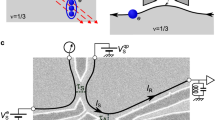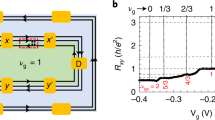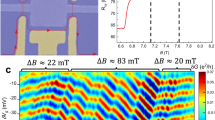Abstract
Shot noise measurements have been used to measure the charge of quasiparticles in the fractional quantum Hall (FQH) regime1,2,3. To induce shot noise in an otherwise noiseless current of quasiparticles, a barrier is placed in its path to cause weak backscattering. The measured shot noise is proportional to the charge of the quasiparticles; for example, at filling factor v=1/3, noise corresponding to q=e/3 appears. For increasingly opaque barriers, the measured charge increases monotonically, approaching q=e asymptotically4,5. It was therefore believed that only electrons, or alternatively, three bunched quasiparticles, can tunnel through high-potential barriers encountered by a noiseless current of quasiparticles. Here we investigate the interaction of e/3 quasiparticles with a strong barrier in FQH samples and find that bunching of quasiparticles in the strong backscattering limit depends on the average dilution of the quasiparticle current. For a very dilute current, bunching ceases altogether and the transferred charge approaches q=e/3. This surprising result demonstrates that quasiparticles can tunnel individually through high-potential barriers originally thought to be opaque for them.
This is a preview of subscription content, access via your institution
Access options
Subscribe to this journal
Receive 51 print issues and online access
$199.00 per year
only $3.90 per issue
Buy this article
- Purchase on Springer Link
- Instant access to full article PDF
Prices may be subject to local taxes which are calculated during checkout





Similar content being viewed by others
References
de Picciotto, R. et al. Direct observation of a fractional charge. Nature 389, 162–164 (1997).
Saminadayar, L., Glattli, D. C., Jin, Y., Etienne, B. Observation of the e/3 fractionally charged Laughlin quasiparticle. Phys. Rev. Lett. 79, 2526–2529 (1997).
Reznikov, M., de-Picciotto, R., Griffiths, T. G., Heiblum, M. & Umansky, V. Observation of quasiparticles with one-fifth of an electron's charge. Nature 399, 238–241 (1999).
Kane, C. L. & Fisher, M. P. A. Nonequilibrium noise and fractional charge in the quantum Hall effect. Phys. Rev. Lett. 72, 724–727 (1994).
Griffiths, T. G., Comforti, E., Heiblum, M., Stern, A. & Umansky, V. Evolution of quasiparticle charge in the fractional quantum hall regime. Phys. Rev. Lett. 85, 3918–3921 (2000).
Schottky, W. Über spontane Stromschwankungen in verschieden Elektrizitätsleitern. Ann. Phys. (Leipzig) 57, 541–567 (1918).
Prange, R. E. & Girvin, S. M. (eds) The Quantum Hall Effect (Springer, New York, 1987).
Laughlin, R. B. Anomalous quantum Hall effect: an incompressible quantum fluid with fractional charge excitations. Phys. Rev. Lett. 50, 1395–1398 (1982).
Khlus, V. K. Current and voltage fluctuations in microjunctions of normal and superconducting metals. Sov. Phys. JETP 66, 1243–1249 (1987).
Lesovik, G. B. Excess quantum noise in 2D ballistic point contacts. JETP Lett. 49, 592–594 (1989).
Comforti, E., Chung, Y. C., Heiblum, M. & Umansky, V. Multiple scattering of fractionally-charged quasiparticles.Preprint cond-mat/0112367 at 〈http://xxx.lanl.gov〉 (2001).
Oliver, W. D., Kim, J., Liu, R. C. & Yamamoto, Y. Hanbury Brown and Twiss-type experiment with electrons. Science 284, 299–301 (1999).
Acknowledgements
The work was partly supported by the Israeli Academy of Science and by the German-Israel Foundation (GIF). We thank A. Yacoby, A. Stern and Y. Levinson for discussions.
Author information
Authors and Affiliations
Corresponding author
Ethics declarations
Competing interests
The authors declare that they have no competing financial interests
Rights and permissions
About this article
Cite this article
Comforti, E., Chung, Y., Heiblum, M. et al. Bunching of fractionally charged quasiparticles tunnelling through high-potential barriers. Nature 416, 515–518 (2002). https://doi.org/10.1038/416515a
Received:
Accepted:
Issue Date:
DOI: https://doi.org/10.1038/416515a
This article is cited by
-
Quasiparticle Andreev scattering in the ν = 1/3 fractional quantum Hall regime
Nature Communications (2023)
-
Shot noise does not always provide the quasiparticle charge
Nature Physics (2022)
-
Topological vacuum bubbles by anyon braiding
Nature Communications (2016)
Comments
By submitting a comment you agree to abide by our Terms and Community Guidelines. If you find something abusive or that does not comply with our terms or guidelines please flag it as inappropriate.



